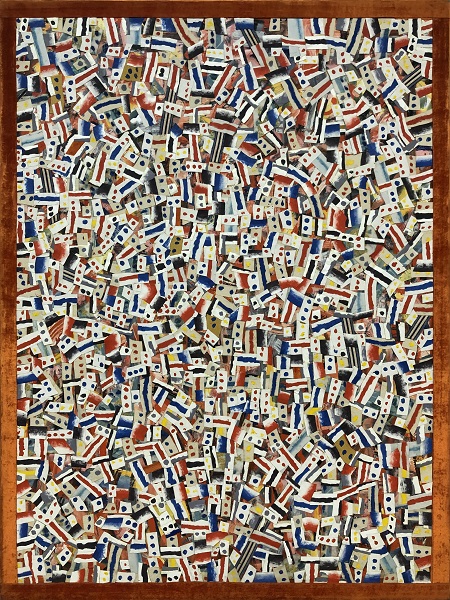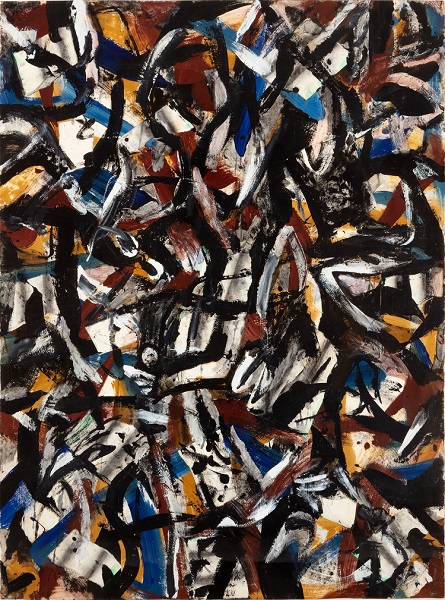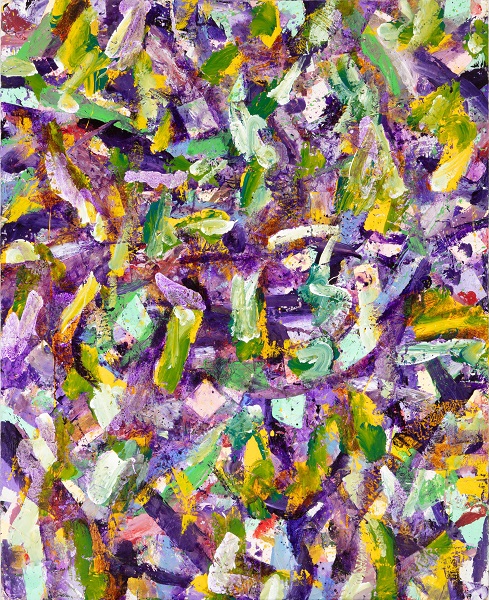“Joseph Glasco: East End Echoes,” at the Pollock-Krasner House and Study Center in Springs, East Hampton, NY, is part of an exhibition series featuring artists linked to Lee Krasner and Jackson Pollock. A photo, likely taken by Krasner around 1953, showing Joseph Glasco (1925-1996) sitting on the steps of The Creeks—the estate of artist patron and artist Alfonso Ossorio—with Ossorio, his companion, dancer Ted Dragon, and Pollock, affirms the connection.
The exhibition, like others here, is installed where Pollock and Krasner lived—the dining, room, living room, and library/study—rather than a separate gallery. Their well-worn Victorian furniture, decorative objects and memorabilia create a fascinating visual interplay with the art.
The exhibition begins with Untitled, 1980-82, a striking example of Glasco's style of the 1980s. This patterned abstract is made from collaged strips of cut canvas painted with dots or stripes, supplemented with decorative printed velvet, and other fabric. Creating a lively and rhythmic texture, these are glued onto a colorful underlying expressionist painting, partially visible as a background.
A tailored orange velvet border around the work's periphery, wrapped around the canvas edge, serves as a neat, artist designed frame. The velvet was borrowed from Julian Schnabel's New York studio where Glasco was staying. Glasco used it without permission, much to his hosts surprise, as explained to me by Pollock-Krasner House Director Helen A. Harrison. Today, the painting is owned by Schnabel. The two were close friends, the older artist regarding Schnabel as a surrogate son.
That the component pieces in Untitled, 1980-82, assume a certain physicality and appear as organized compositions of dispersed fragments, brings to mind Schnabel's plate paintings of the same era, and images of tesserae in mosaics. The all-over compositional approach is reminiscent of Pollock as well.
.

"Untitled" by Joseph Glasco, 1980-82. Acrylic and collage on canvas with velvet, 96 x 72 inches. Collection of Julian Schnabel. Courtesy Pollock-Krasner House and Study Center.
.
By the 1990s, Glasco's style had changed. This is dramatized by the nearby installation of Untitled, 1993 (whose earth toned palette is familiar from the work of both Pollock and Krasner) and Untitled, 1994. Both paintings show Glasco's personal take on Abstract-Expressionism's hallmark brushwork: luscious paint, thick or liquified, applied in broad curving strokes, with dance-like twists, elongated drips and occasional splatters. Glasco worked on paper, whose smooth surface facilitated his paint handling and enabled collage techniques that discreetly blended into the painting's surface.
.

"Untitled" by Joseph Glasco, 1993. Oil and collage on paper, 54 1/2 x 40 inches. Courtesy Talley Dunn Gallery, Dallas, and Pollock-Krasner House and Study Center.
.

"Untitled" by Joseph Glasco, 1994. Acrylic and collage on paper, 50 x 38 inches. Courtesy Talley Dunn Gallery, Dallas, and Pollock-Krasner House and Study Center.
.
Glasco orchestrates the resulting configurations into tight, intricate, and layered compositions, interweaving varied gestural brush strokes with rectilinear elements, as shown in three works Untitled, 1996, Untitled, 1996, and Untitled, 1995, presented triptych style behind the Pollock's commanding round dining table.
.

"Untitled" by Joseph Glasco, 1996. Acrylic on paper, 27 1/2 x 19 1/2 inches. Courtesy Talley Dunn Gallery, Dallas, and Pollock-Krasner House and Study Center.
.

"Untitled" by Joseph Glasco, 1996. Acrylic on paper, 29 3/4 x 23 inches. Courtesy Talley Dunn Gallery, Dallas, and Pollock-Krasner House and Study Center.
.

"Untitled" by Joseph Glasco, 1995. Acrylic on paper, 27 1/2 x 19 1/2 inches. Courtesy Talley Dunn Gallery, Dallas, and Pollock-Krasner House and Study Center.
.
A single larger work nearby, Untitled, ca. 1995, in rich tints of purple and lavender with touches of green, further pulls together these visual motifs, the surface becoming one continuous whole with many layers yet with constituent elements clearly visible. Textured effects arise from translucent pigment, painted wet over dry.
.

"Untitled" by Joseph Glasco, ca. 1995. Acrylic on paper, 40 x 32 1/2 inches. Courtesy Talley Dunn Gallery, Dallas, and Pollock-Krasner House and Study Center.
.
In two paintings over the library sofa, both Untitled, 1996, strong geometric structure is sustained amidst otherwise gestural elements. Here, bands of solid color in white, black or pink, as well as box-like shapes, emerge from slashing brushstrokes.
.

"Untitled" by Joseph Glasco, 1996. Acrylic on paper, 27 1/4 x 19 1/2 inches. Courtesy Talley Dunn Gallery, Dallas, and Pollock-Krasner House and Study Center.
.
Marked by spontaneity of gesture and improvisation in execution, these are painterly paintings, done with verve, energy and an almost profligate abundance of materials. Glasco's extensive studio practice is evident in his unfailing grasp of the physical properties of his pigments, their weight, viscosity, drying times, and the idiosyncratic character of each hue. This, together with the artist's keen sense of compositional balance and proportion gives the works a sense of finish, and decisive completeness.
Why is Glasco not better known? It would take a big museum, like the Guggenheim, to fully portray his evolution in a dedicated survey. At the outset of his career, more of a figurative artist, though open to the avant-garde, he changed style as the impulse struck him.
Like Jackson Pollock, Glasco, came from pioneer stock, but the Glasco family made a fortune in oil. Episodic payments from this inheritance largely freed Glasco from the art market. Never compelled to live exclusively from his art, nor driven to achieve great prominence, he resisted adopting a singular style. This is tough for historians or the art market to digest.
Glasco was born in Oklahoma, lived in Texas through much of his life, and after serving in World War II, studied art in England, Los Angeles, Mexico, and then New York at The Art Students League, where he was introduced to artists in Pollock and Krasner's circle. Glasco gained renown early in his career.
Included in the Museum of Modern Art's famed exhibition “Fifteen Americans” in 1952 along with Pollock, Rothko, Still and Baziotes, and showing at esteemed galleries like Perls (at age 25) and Catherine Viviano, his works were collected by the Museum of Modern Art, The Whitney and the Metropolitan Museum of Art.
He traveled extensively, especially to Europe, the Canary Islands, Morocco and Greece, with extended periods in Taos, as well as Long Island's East End. Glasco was in The Hamptons for two periods: during the 1950s when he became friends with Pollock, who became his biggest influence, and during the 1990s when he stayed in Montauk with Julian Schnabel.
Glasco exemplifies the phenomenon of significant artists who, as the saying goes, fall through the cracks of history. The exhibition goes a long way to remedy this. I'm glad to have seen it. The title, “East End Echoes” is apt, because it resonates with the aesthetic impact of his rapport with other artists in the region: especially with Pollock, Krasner, Ossorio and Schnabel. Viewing his work at the Pollock-Krasner House is all the better because we see Glasco as if in the supportive atmosphere of friends.
Items owned by Krasner and Pollock, which here surround Glasco's paintings, ranging from books of vanguard literature (e.g. Ulysses, Finnegan's Wake), volumes on art from Picasso and Miro to Egyptian painting, and jazz phonograph records, along with items from nature like seashells, starfish, rocks and reeds, remind us that art making was understood to be one choice among others for the pursuit of a creative life, integral to an atmosphere where fulfillment of the mind and spirit were prioritized.
This is a useful reminder in our era of mega-exhibitions, mega-galleries, and vast art fairs. The Pollock-Krasner House space is intimate and personal, yet it provides vivid and highly accessible evidence of the ongoing narrative of twentieth century art. Looking at subsequent works in this setting, we get a better appreciation of how those two inspired their fellow artists, of their own time, and those who follow.
"Joseph Glasco: East End Echoes" was curated by Marti Mayo, who also organized the 1986 survey, “Joseph Glasco 1948-1986: A Sesquicentennial Exhibition” at the Contemporary Art Museum, Houston, Texas.
___________________________
BASIC FACTS: “Joseph Glasco: East End Echoes” is on view May 2 to July 27, 2019 at the Pollock-Krasner House and Study Center, Springs Fireplace Rd, in the Historic Springs of East Hampton, NY 11937. www.stonybrook.edu.
___________________________
Copyright 2019 Hamptons Art Hub LLC. All rights reserved.
